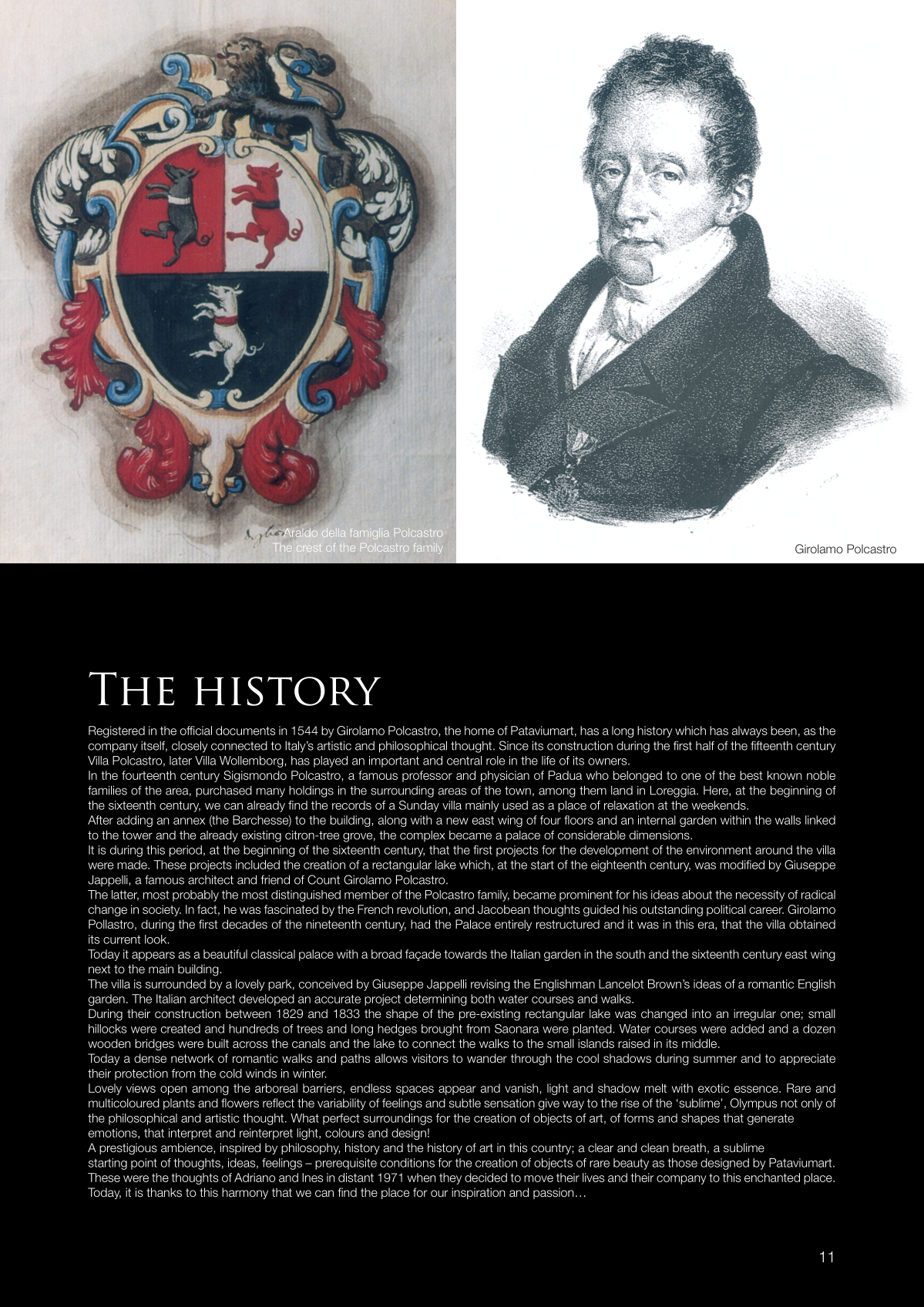The history
Registered in the official documents in 1544 by Girolamo Polcastro, the home of Pataviumart, has a long history which has always been, as the
company itself, closely connected to Italy’s artistic and philosophical thought. Since its construction during the first half of the fifteenth century
Villa Polcastro, later Villa Wollemborg, has played an important and central role in the life of its owners.
In the fourteenth century Sigismondo Polcastro, a famous professor and physician of Padua who belonged to one of the best known noble
families of the area, purchased many holdings in the surrounding areas of the town, among them land in Loreggia. Here, at the beginning of
the sixteenth century, we can already find the records of a Sunday villa mainly used as a place of relaxation at the weekends.
After adding an annex (the Barchesse) to the building, along with a new east wing of four floors and an internal garden within the walls linked
to the tower and the already existing citron-tree grove, the complex became a palace of considerable dimensions.
It is during this period, at the beginning of the sixteenth century, that the first projects for the development of the environment around the villa
were made. These projects included the creation of a rectangular lake which, at the start of the eighteenth century, was modified by Giuseppe
Jappelli, a famous architect and friend of Count Girolamo Polcastro.
The latter, most probably the most distinguished member of the Polcastro family, became prominent for his ideas about the necessity of radical
change in society. In fact, he was fascinated by the French revolution, and Jacobean thoughts guided his outstanding political career. Girolamo
Pollastro, during the first decades of the nineteenth century, had the Palace entirely restructured and it was in this era, that the villa obtained
its current look.
Today it appears as a beautiful classical palace with a broad façade towards the Italian garden in the south and the sixteenth century east wing
next to the main building.
The villa is surrounded by a lovely park, conceived by Giuseppe Jappelli revising the Englishman Lancelot Brown’s ideas of a romantic English
garden. The Italian architect developed an accurate project determining both water courses and walks.
During their construction between 1829 and 1833 the shape of the pre-existing rectangular lake was changed into an irregular one; small
hillocks were created and hundreds of trees and long hedges brought from Saonara were planted. Water courses were added and a dozen
wooden bridges were built across the canals and the lake to connect the walks to the small islands raised in its middle.
Today a dense network of romantic walks and paths allows visitors to wander through the cool shadows during summer and to appreciate
their protection from the cold winds in winter.
Lovely views open among the arboreal barriers, endless spaces appear and vanish, light and shadow melt with exotic essence. Rare and
multicoloured plants and flowers reflect the variability of feelings and subtle sensation give way to the rise of the ‘sublime’, Olympus not only of
the philosophical and artistic thought. What perfect surroundings for the creation of objects of art, of forms and shapes that generate
emotions, that interpret and reinterpret light, colours and design!
A prestigious ambience, inspired by philosophy, history and the history of art in this country; a clear and clean breath, a sublime
starting point of thoughts, ideas, feelings – prerequisite conditions for the creation of objects of rare beauty as those designed by Pataviumart.
These were the thoughts of Adriano and Ines in distant 1971 when they decided to move their lives and their company to this enchanted place.
Today, it is thanks to this harmony that we can find the place for our inspiration and passion…
Araldo della famiglia Polcastro
The crest of the Polcastro family
Girolamo Polcastro
11
105791_00_INTRO.indd 11
29/03/10 10:09


